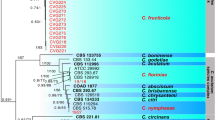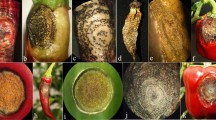Abstract
Colletotrichum is an important fungal genus with great diversity, which causes anthracnose of a variety of crop plants including rubber trees. Colletotrichum acutatum and Colletotrichum gloeosporioides have been identified as the major causative agents of Colletotrichum leaf disease of rubber trees in Sri Lanka based on morphology, pathogenicity, and the analysis of internally transcribed spacer sequences of the nuclear ribosomal DNA. This study has been conducted to investigate the members of the C. acutatum species complex causing rubber leaf disease using a morphological and multi gene approach. For the first time in Sri Lanka, Colletotrichum simmondsii, Colletotrichum laticiphilum, Colletotrichum nymphaeae, and Colletotrichum citri have been identified as causative agents of Colletotrichum leaf disease in addition to C. acutatum s. str. Among them, C. simmondsii has been recognized as the major causative agent.






Similar content being viewed by others
References
Bailey JA, Jeger MJ (1992) Colletotrichum: biology, pathology and control. Commonwealth Mycological Institute, Wallingford
Brown AE, Soepena H (1994) Pathogenicity of Colletotrichum acutatum and C. gloeosporioides on leaves of Hevea spp. Mycol Res 98(3):264–266
Cai L, Hyde KD, Taylor PWJ, Weir BS, Waller J, Abang MM, Zang JZ, Yang YL, Phoulvong S, Liu ZY, Prihastuti H, Shivas R G, McKenzie EHC, Johnstan PR (2009) A polyphasic approach for studying Colletotrichum. Fungal Divers 39:183–204
Cannon PF, Bridge PD, Monte E (2000) Linking the past, present and future of Colletotrichum systematics. In: Prusky D, Freeman S, Dickman MB (eds) Colletotrichum: host specificity, pathology and host pathogen interaction. APS press, St Paul
Carbone I, Kohn LM (1999) A method for designing primer sets for speciation studies in filamentous ascomycetes. Mycologia 91:553–556
Crous PW, Groenewald JZ, Risede JM, Hywel-Jones NL (2004) Calonectria species and their Cylindrocladium anamorphs: species with sphaeropedunculate vesicles. Stud Mycol 50:415–430
Damm U, Cannon PF, Woudenberg JHC, Crous PW (2012) The Colletotrichum acutatum species complex. Stud Mycol 73(1):37–113
Damm U, Cannon PF, Woudenberg JHC, Johnston PR, Weir BS, Tan YP, Shivas RG, Crous PW (2012) The Colletotrichum boninense species complex. Stud Mycol 73:1–36
Du MZ, Schardl CL, Vaillancourt LJ (2005) Using mating- type gene sequence for improved phylogenetic resolution of Colletotrichum species complexes. Mycologia 97:641–658
Edgar RC (2004) MUSCLE: multiple sequence alignment with high accuracy and high throughput. Nucleic Acid Res 32(5):1792–1797
Farr DF, Aime, MC, Rossman AY, Palm ME (2006) Species of Colletotrichum on Agavaceae. Mycol Res 110:1395–1408
Gazis R, Chaverri P (2010) Diversity of fungal endophytes in leaves and stems of wild rubber trees (Hevea brasiliensis) in Peru. Fungal Ecol 3:240–254
Glass NL, Donaldson GC (1995) Development of primer sets designed for use with the PCR to amplify conserved genes from filamentous ascomycetes. Appl Environ Microbiol 61:1323–1330
Guerber JC, Liu B, Correll JC, Johnston PR (2003) Characterization of diversity in Colletotrichum acutatum sensu lato by sequence analysis of two gene introns, mtDNA and intron RFLPs, and mating compatibility. Mycologia 95:872–895
Guyot J, Omanda EN, Pinard F (2005) Some epidemiological investigations on Colletotrichum leaf disease on rubber tree. Crop Prot 24(1):65–77
Hall TA (1999) BioEdit: a user friendly biological sequence alignment editor and analysis program for windows 95/98/NT. Nucl Acids Symp Ser 41:95–98
Ho WC, Ko WH (2007) A simple method for obtaining single spore isolates of fungi. Bot Bull Acad Sin 38:41–43
Hunupolagama DM, Fernando THPS, Wijesundera RLC, Chandrasekharan NV, Wijesundera WSS (2014) A high yielding and low cost protocol for extract genomic DNA from Colletotrichum sp. which can effectively use in phylogenetic studies. In proceedings of 10th International Mycological Congress, Thailand. p 752
Hung F, Chen GQ, Hou X, Fu YS, Cai L, Hyde KD, Li HY (2013) Colletotrichum species associated with cultivated citrus in China. Fungal Divers 61:61–74
Hyde KD, Cai L, Cannon PF, Crouch JA, Crous PW et al (2009) Colletotrichum—names in current use. Fungal Divers 39:147–182
Jayasinghe CK, Fernando THPS (1998) Growth at different temperatures and on fungicide amended media: two characteristics to distinguish Colletotrichum species pathogenic to rubber. Mycopathologia 143:93–95
Jayasinghe CK, Fernando THPS, Priyanka UMS (1997) Colletotrichum acutatum is the main cause of Colletotrichum leaf disease of rubber in Sri Lanka. Mycopathologia 137:53–56
Johnson DA, Carris LM, Rogers JD (1997) Morphological and molecular characterization of Colletotrichum nymphaeae and C. nupharicola sp. Nov. on water-lilies (Nymphaea and Nuphar). Mycol Res 101(6):641–649
McKay SF, Freeman S, Minz D, Maymon M, Sedgley M, Collins GC, Scott ES (2009) Morphological genetic and pathogenic characterization of Colletotrichum acutatum, the cause of anthracnose of Almond in Australia. Phytopathology 99(8):985–995
Mitra M, Mehta PR (1938) Diseases of Hevea brasiliensis new to India. Indian J Agric Sci 8:185–188
Muthumeenakshi S (1996) Molecular taxonomy of the genus Trichoderma. Ph. D. thesis, The Queen’s University of Belfast, United Kingdom
O’Donnell K, Cigelnik E (1997) Two divergent intragenomic rDNA ITS2 types within a monophyletic lineage of the fungus Fusarium are nonorthologous. MoI Phylogenet Evol 7:103–116
O’Donnell K, Nirenberg HI, Aoki T, Cigelnik E (2000) A Multigene phylogeny of the Gibberella fujikuroi species complex: detection of additional phylogenetically distinct species. Mycoscience 41:61–78
Phoulivong S, Cai L, Chen H, McKenzie EHC, Abdelsalam K, Chukeatirote E, Hyde KD (2010) Colletotrichum gloeosporioides is not a common pathogen on tropical fruits. Fungal Divers 44(1):33–43. doi:10.1007/s13225-010-0046-0
Saha T, Kumar A, Ravindran M, Jacobs K, Roy B, Nazeer MA (2002) Identification of Colletotrichum acutatum from rubber using random amplified polymorhic DNAs and ribosomal DNA polymorphisms. Mycol Res 106:215–221
Shivas RG, Tan YP (2009) A taxonomic re-assessment of Colletotrichum acutatum, introducing C. fioriniae comb. et stat. nov. andC. simmondsii sp. nov. Fungal Divers 39:111–122
Small S (1926) On the occurrences of a species of Colletotrichum. Trans Br Mycol Soc 11(1–2):112–137
Sreenivasaprasad S, Talhinhas P (2005) Genotypic and phenotypic diversity in Colletotrichum acutatum, a cosmopolitan pathogen causing anthracnose on a wide range of hosts. Mol Plant Pathol 6:361–378
Sutton BC (1980) The coelomycetes, fungi imperfecti with pycnidia, acervuli and stromata. Common wealth mycological institute, Kew
Sutton BC (1992) The genus Glomerella and its anamorph Colletotrichum. In: Bailey JA, Jeger MJ (eds) Colletotrichum: Biology, pathology and control. CAB International, Wallingford, pp 1–26
Talhinhas P, Sreenivasaprasad S, Neves-Martins J, Oliveira H (2002) Genetic and morphological characterization of Colletotrichum acutatum causing anthracnose of Lupins. Phytopathology 92(9):986–996
Tamura K (1992) Estimation of the number of nucleotide substitutions when there are strong transition-transversion and G + C-content biases. Mol Biol Evol 9:678–687
Tamura K, Stecher G, Peterson D, Filipski A, Kumar S (2013) MEGA6: molecular evolutionary genetics analysis version 6.0. Mol Biol Evol 30:2725–2729
Templeton MD, Rikkerink EHA, Solon SL, Crowhurst RN (1992) Cloning and molecular characterization of the glyceraldehyde-3-phosphate dehydrogenase encoding gene and cDNA from the plant pathogenic fungus Glomerella cingulata. Gene 122:225–230
Thambugala TADP, Deshappriya N (2009) The role of Colletotrichum species on the Colletotrichum leaf disease of Hevea brasiliensis—a preliminary study. J Natl Sci Found Sri Lanka 37:135–138
Than PP, Jeewon R, Hyde KD, Pongsupasamit S, Mongkolporn O, Taylor PWJ (2008) Characterization and pathogenicity of Colletotrichum species associated with anthracnose on chili (Capsicum spp.) in Thailand. Plant Pathol 57:562–572
Tshering K (2006) Host-pathogen interaction of Colletotrichum capsici on chili peppers. M. Sc. Thesis, The University of Melbourne
Velho AC, Stadnik MJ, Casanova L, Mondino P, Alaniz S (2014) First report of Colletotrichum nymphaeae causing apple bitter rot in southern Brazil. Plant Dis 98(4):567
Wastie RL, Janardhanan PS (1970) Pathogenicity of Colletotrichum gloeosporioides, C. dematium and C. crassipes to leaves of Hevea brasiliensis. Trans Br Mycol Soc 54(1):150–152
Weir BS, Johnston PR, Damm U (2012) The Colletotrichum gloeosporioides species complex. Stud Mycol 73:115–180
Weir JR (1926) A pathological survay of the para rubber tree (Hevea barasiliensis) in the Amazon valley. U S Dep Agric Bull 1380:129
Yamagashi N, Sato T, Chuma I, Ishiyama Y, Tosa Y (2016) Anthracnose of black locust caused by Colletotrichum nymphaeae (Passerini) Aa. J Gen Plant Pathol 82(3):174–176
Funding
This study was supported by HETC project (HETC/CMB/SCI/TOR8).
Author information
Authors and Affiliations
Corresponding author
Electronic supplementary material
Below is the link to the electronic supplementary material.
Rights and permissions
About this article
Cite this article
Hunupolagama, D.M., Chandrasekharan, N.V., Wijesundera, W.S.S. et al. Unveiling Members of Colletotrichum acutatum Species Complex Causing Colletotrichum Leaf Disease of Hevea brasiliensis in Sri Lanka. Curr Microbiol 74, 747–756 (2017). https://doi.org/10.1007/s00284-017-1238-6
Received:
Accepted:
Published:
Issue Date:
DOI: https://doi.org/10.1007/s00284-017-1238-6




